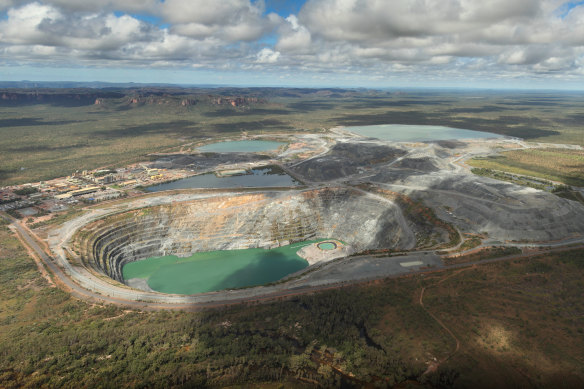By Nick Toscano
Mining giant Rio Tinto will take control of the rehabilitation of the closed Ranger uranium mine in the Northern Territory, which has been beset by major delays and more than $1.7 billion in budget blowouts.
Rio Tinto’s majority-owned Energy Resources of Australia (ERA), once a prominent producer of uranium oxide, ceased operations at Ranger near the World Heritage-listed Kakadu National Park in 2021, with an initial plan to complete the site’s clean-up and rehabilitation by 2026 at an estimated cost of about $500 million.

The Ranger uranium mine in Kakadu National Park.Credit: Glenn Campbell
Following a series of cost blowouts, however, ERA warned investors in September that the cost was now on track to “materially exceed” $2.2 billion, and the targeted completion date would be delayed until after 2028.
Rio Tinto, which owns 86.3 per cent of ERA, said on Wednesday it had reached an agreement with ERA to take over management of the program.
The Anglo-Australian mining giant said its aim was to complete the works in the safest and most efficient way and to a standard that would establish an environment similar to the adjacent to the Kakadu National Park, consistent with the wishes of the Mirarr traditional owners.
“With the signing of this agreement, we are pleased to be able to directly provide more closure and project delivery experience and know-how to this critical task,” Rio Tinto’s chief executive of Australia, Kellie Parker, said in a statement.

Jabiluka was developed and prepared for mining before work was stopped, following huge backlash, including this rally in Melbourne in 1999.Credit: The Age
Tensions between Rio Tinto and ERA over the rehabilitation’s cost and schedule overruns came to a head in 2022 when Rio Tinto demanded the resignation of chairman Peter Mansell.
Calling for “board renewal”, Rio Tinto at the time cited the need for new perspectives to address the Ranger rehabilitation. It also raised concerns that ERA’s board was failing to properly recognise Mirarr traditional owners’ long-standing opposition to mining resuming around Ranger – specifically, at the neighbouring Jabiluka deposit, one of the world’s richest known sources of untapped uranium.
The Gundjeihmi Aboriginal Corporation, representing the Mirarr traditional owners, on Wednesday welcomed the news that Rio Tinto had agreed to take over the rehabilitation, adding they had “lost all confidence” in ERA’s capacity to clean up Ranger as it became apparent it was struggling to cover the cost.
However, traditional owner Corben Mudjandi said it was disappointing that the Jabiluka mineral lease would remain under ERA’s management.
“It’s time for both the Northern Territory and Commonwealth governments to pay attention to Kakadu and dismiss the notion that ERA is in any state to hold on to a mineral lease anywhere, let alone over dual World Heritage-listed country that a generation of Australians fought to protect,” Mudjandi said.
Concerns about mining at Jabiluka sparked fierce opposition among traditional owners and environmental campaigners in 1998 when thousands took part in a human blockade at the site and hundreds were arrested. The lease area covers a sacred site with hundreds of ancient rock art galleries.
Jabiluka was never mined, and ERA has pledged not to do so as long as the Mirarr people remain opposed to it. Last month, however, ERA drew the ire of traditional owners by applying for a 10-year renewal of its mining lease.
Rio Tinto, one of the world’s largest miners, has been seeking to strengthen its ties with First Nations communities and improve its approach to cultural heritage across its far-flung operations following the destruction of the 46,000-year-old Juukan Gorge rock shelters in Western Australia in 2020.
Conservationists on Wednesday cautiously welcomed Rio Tinto taking over Ranger’s rehabilitation, saying it was “far better placed to deliver credible outcomes” than ERA.
“There is a massive shortfall in funding for the Ranger clean-up and put simply, Rio has deeper pockets, more talent and greater reputational exposure than ERA,” the Australian Conservation Foundation’s Dave Sweeney said.
“In the shadow of Juukan Gorge, Rio Tinto will continue to be closely watched and long judged for its performance on this clean-up.”
ERA said it had asked Rio Tinto to submit a proposal to provide services and advice to progress the rehabilitation project. ERA chief executive Brad Welsh said the company had made “good progress” rehabilitating Ranger so far. “However, as the project moves into a new phase it will benefit from Rio Tinto’s global expertise in mine closure,” he said.
Despite having a complete ban on domestic nuclear energy, Australia has significant known uranium resources and is a prominent supplier in the global uranium market.
Opposition Leader Peter Dutton has reignited the debate over the use of Australia’s uranium supplies by proposing to deploy nuclear power generators across the country if the Coalition wins government.
The Market Recap newsletter is a wrap of the day’s trading. Get it each weekday afternoon.